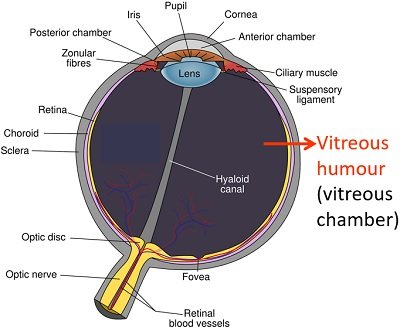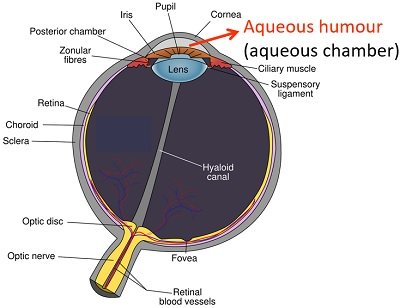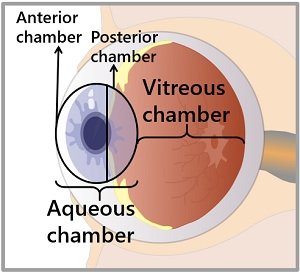The difference between vitreous humour and aqueous humour is primarily in the location within the eye. Vitreous humour is a gelatinous mass occupying the vacant space within the eye lens and the retina. Aqueous humour is a watery fluid occupying the cavity within the cornea and the eye lens.
The eye-cavity has distinct two chambers, namely the small aqueous and large vitreous chambers. The former is filled with a clear watery fluid called the aqueous chamber. Oppositely, the latter is filled with the transparent gelatinous material called the vitreous chamber.
This post mainly describes the key differences between vitreous and aqueous humour along with the comparison chart. You will also get to know the definition, diagram and functions between the two.
Content: Vitreous Humour Vs Aqueous Humour
Comparison Chart
| Properties | Vitreous Humor | Aqueous Humor |
|---|---|---|
| Alternative name | Vitreous gel or vitreous body | Aqueous fluid or aqueous body |
| Meaning | Vitreous humor is a gelatinous fluid that spans the posterior segment of the eye lens | Aqueous humor is a watery, transparent fluid that spans the anterior segment of the eye (from cornea to eye lens) |
| Nature | Gel-like consistency | Plasma-like fluid |
| Location | It fills the eye’s vitreous chamber that lies back of the eyeball | It occupies the eye’s aqueous chamber that is subdivided into anterior and posterior chambers |
| Water content | Vitreous fluid contains 99% water | Aqueous fluid contains 99.9% water |
| Trace elements | It comprises 1% trace elements like collagen, proteins, salts and sugars | It comprises 0.1% trace elements such as sugars, vitamins, proteins and other nutrients |
| Volume | Its volume is comparatively higher (generally 3.9 ml) | It has a low volume (0.25 ml) |
| Formation | Collagenous fibers form the vitreous body once during the embryonic development | Ciliary processes near the eye lens form the aqueous fluid |
| Replenishment | Vitreous fluid cannot be replenished or regenerated, once it degenerates | Aqueous fluid can be replenished by the ciliary bodies |
| Flow | It does not flow | It constantly flows from the posterior chamber to the anterior chamber |
| Secretion and absorption | Vitreous fluid is of permanent nature, i.e. it is neither absorbed, nor replaced | Aqueous fluid is continuously secreted by ciliary bodies and absorbed into the canal of Schlemm |
| Functions | It keeps the retina in place and serves as a shock absorber | It nourishes the eye and maintains the intraocular pressure |
| Eye problems | Vitreous detachment, retinal tear etc. are severe eye problems associated with the vitreous fluid | Glaucoma, Ocular hypertension, cataract etc. are refractive errors associated with the aqueous fluid |
Definition of Vitreous Humour
It refers to a gelatinous fluid that seems clear and colourless. Vitreous humour spans the vitreous chamber that lies posterior of the eyeball. The vitreous chamber accounts for 80% of the eye. It forms once during the embryonic development by the embryonic mesenchyme cells after age 4-5.

Vitreous producing embryonic mesenchyme cells degenerate after birth. A layer of collagen (hyaloid membrane or vitreous cortex) separates the vitreous fluid from the rest of the portion. Its consistency near the centre is fluid-like and gel-like near the edges.
What are the Eye Problems associated with Vitreous Humour?
- Vitreous detachment is a clinical condition causing shrinkage of the retinal fibres that pull away all at once.
- The vitreous haemorrhage causes a reddish tint in your vision or blurry vision.
- The retina tear is a severe problem that occasionally develops due to a vitreous detachment. It causes clumping of retinal fibres on the retinal surface that eventually causes tearing of the sensitive retinal tissues.
Definition of Aqueous Humour
It refers to a plasma-like fluid that seems thin and transparent. Aqueous humour fills the aqueous chamber that spans the anterior and posterior segments of the eye. The anterior segment is the cavity lying between the cornea and iris, while the posterior segment is the cavity between the iris and lens.

Both the segments are filled with aqueous fluid. The ciliary body possesses non-pigmented epithelium cells (pars plicata) that produce the aqueous fluid into the posterior chamber. Aqueous fluid flows from the posterior into the anterior chamber via the pupil and is finally absorbed by the sclera venous sinus or Schlemm’s canal.
What are the Eye Problems associated with Aqueous Humour?
- Glaucoma is a severe eye problem that leads to vision loss and blindness by damaging the optic nerves in the back of the eye.
- A cataract is a condition forming a cloudy or dense layer over the eye lens.
- Ocular hypertension occurs due to poor drainage of the aqueous humour.
Functions of Vitreous Humour
- Vitreous humour maintains the eye’s spherical shape.
- It is good at transmitting light rays to the retina.
- The pressure of vitreous fluid holds the inner and pigmented layer of the retina in place.
- It also serves as a stabilizer and shock absorber.
Functions of Aqueous Humour
- Aqueous humour lubricates the anterior segment of the eye.
- It picks up the metabolic wastes and drains them into the Schlemm’s canal.
- It also maintains eye health by nourishing the cornea and lens through a constant supply of amino acids and glucose.
- Aqueous humour maintains intraocular pressure.
- It protects the eye against dust, pollen grains, wind etc.
Key Differences Between Vitreous Humour and Aqueous Humor
- The vitreous body is a gelatinous fluid that spans the posterior segment of the eye lens. Oppositely, the aqueous body is a watery or transparent fluid that spans the anterior segment of the eye (from the cornea to the eye lens).
- Vitreous fluid fills the eye’s vitreous chamber that lies back of the eyeball. Conversely, the aqueous fluid that fills the eye’s aqueous chamber is subdivided into anterior and posterior compartments.

- The composition of vitreous fluid contains 99% water and 1% trace elements like collagen, proteins, salts and sugars. The aqueous fluid contains 99.9% water and 0.1% trace elements such as sugars, vitamins, proteins and other nutrients.
- The volume of vitreous fluid is comparatively higher (generally 3.9 ml) than the aqueous fluid (0.25 ml), as the former constitutes the fourth-fifth portion of the eyeball.
- Vitreous fluid produces once in a lifetime, generally during embryonic development. Thus, it is neither secreted nor absorbed, or the vitreous body cannot be replenished after its degeneration. However, the eyes continuously secrete and drain out the aqueous fluid. Ciliary bodies and the Schlemm’s canal help in the secretion and absorption of aqueous fluid.
Conclusion
Both vitreous and aqueous humour fills the empty spaces of the eye to supply enough internal pressure to maintain the eye’s shape. Thus, these fluids are essential for eye health, and any problems with them can potentially cause adverse effects on your vision.